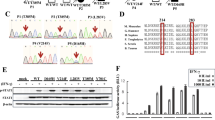Abstract
Artemis (DCLRE1C) is involved in opening recombination-activating gene (RAG1/RAG2)-generated hairpins during V(D)J recombination, an essential process for the differentiation and maturation of T and B cells. Here, we reported a case of 5-month-old boy with recurrent respiratory infections, disseminated Bacille Calmette-Guérin (BCG) infection, generalized erythroderma, hepatosplenomegaly, lymphadenopathy, eosinophillia and failure to thrive, symptoms often observed in Omenn syndrome. Genetic analysis revealed compound heterozygous mutations of the DCLRE1C gene, including deletions of exons 1 and 2, and a c. 352G>T (p. G118X) nonsense mutation in exon 5. Flow cytometry analysis of the patient PBMCs indicated a TlowB-NK+ immunophenotype. Short tandem repeat (STR) analysis confirmed transplacental maternal lymphocytes engraftment in circulating blood of the patient. Collectively, we reported a patient showing atypical immunophenotypic and typical clinical presentations of Severe Combined Immunodeficiency (SCID) with Graft Versus Host Disease (GVHD) in the context of compound heterozygous mutations of the DCLRE1C gene. This study adds to the ever-growing knowledge on the broad immunological and clinical spectrum associated with DCLRE1C mutations.






Similar content being viewed by others
References
Bajin IY et al (2013) Atypical combined immunodeficiency due to Artemis defect: a case presenting as hyperimmunoglobulin M syndrome and with LGLL. Mol Immunol 56(4):354–7
Buckley RH (2012) The long quest for neonatal screening for severe combined immunodeficiency. J Allergy Clin Immunol 129(3):597–604; quiz 605-6
de Villartay JP (2015) Congenital defects in V(D)J recombination. Br Med Bull 114(1):157–67
Ege M et al (2005) Omenn syndrome due to ARTEMIS mutations. Blood 105(11):4179–86
Felgentreff K et al (2015) Functional analysis of naturally occurring DCLRE1C mutations and correlation with the clinical phenotype of ARTEMIS deficiency. J Allergy Clin Immunol 136(1):140–150 e7
Gui J et al (2011) MCL1 increases primitive thymocyte viability in female mice and promotes thymic expansion into adulthood. Int Immunol 23(10):647–59
Haddad E et al (2018) SCID genotype and 6-month posttransplant CD4 count predict survival and immune recovery. Blood 132(17):1737–1749
Le Deist F et al (2004) Artemis sheds new light on V(D)J recombination. Immunol Rev 200:142–55
Lee PP et al (2013) The many faces of Artemis-deficient combined immunodeficiency - two patients with DCLRE1C mutations and a systematic literature review of genotype-phenotype correlation. Clin Immunol 149(3):464–74
Li L et al (2002) A founder mutation in Artemis, an SNM1-like protein, causes SCID in Athabascan-speaking Native Americans. J Immunol 168(12):6323–9
Liu C et al (2016) Maternal T-cell engraftment interferes with human leukocyte antigen typing in severe combined immunodeficiency. Am J Clin Pathol 145(2):251–7
Mah AY et al (2017) Glycolytic requirement for NK cell cytotoxicity and cytomegalovirus control. JCI insight 2(23)
Moshous D et al (2001) Artemis, a novel DNA double-strand break repair/V(D)J recombination protein, is mutated in human severe combined immune deficiency. Cell 105(2):177–86
Müller SM, Ege M, Pottharst A, Schulz AS, Schwarz K, Friedrich W (2001) Transplacentally acquired maternal T lymphocytes in severe combined immunodeficiency: a study of 121 patients. Blood 98 (6):1847–1851
Pannicke U et al (2010) The most frequent DCLRE1C (ARTEMIS) mutations are based on homologous recombination events. Hum Mutat 31(2):197–207
Shahbazi Z et al (2019) Graft versus host disease and microchimerism in a JAK3 deficient patient. Allergy Asthma Clin Immunol 15:47
van der Burg M et al (2007) Defective Artemis nuclease is characterized by coding joints with microhomology in long palindromic-nucleotide stretches. Eur J Immunol 37(12):3522–8
van Zelm MC et al (2011) PID comes full circle: applications of V(D)J recombination excision circles in research, diagnostics and newborn screening of primary immunodeficiency disorders. Front Immunol 2:12
Yang C et al (2019) Whole exome sequencing identifies a novel predisposing gene, MAPKAP1, for familial mixed mood disorder. Front Genet 10:74
Funding
This work was supported by grants from National Natural Science Foundation of China (No. 81802491), Beijing Talent Fund (No. 2016000021469G201) and Beijing Municipal Science & Technology Commission (No. Z181100001718061).
Author information
Authors and Affiliations
Contributions
WM, JG, and JH designed most of the studies. WM carried out much of the work together with LG, JH, BX, and JG. WM, JG, and JH analyzed the data. WM wrote up the manuscript with input from JG and JH. All the authors read and approved the final manuscript.
Corresponding authors
Ethics declarations
Conflict of interest
The authors declare no competing interests.
Ethics approval and informed consent
All patients (and/or their guardians) signed an informed consent to participate in this study, approved by the Ethics Committee of the Beijing Children’s Hospital, and to authorize the publication of clinical images.
Additional information
Publisher's Note
Springer Nature remains neutral with regard to jurisdictional claims in published maps and institutional affiliations.
Rights and permissions
About this article
Cite this article
Mou, W., Gao, L., He, J. et al. Compound heterozygous DCLRE1C mutations lead to clinically typical Severe Combined Immunodeficiency presenting with Graft Versus Host Disease. Immunogenetics 73, 425–434 (2021). https://doi.org/10.1007/s00251-021-01219-4
Received:
Accepted:
Published:
Issue Date:
DOI: https://doi.org/10.1007/s00251-021-01219-4




